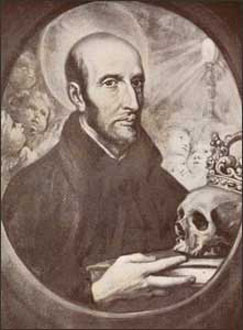| St. Francis Borgia  AKA Francisco de Borja AKA Francisco de Borja
Born: 28-Oct-1510
Birthplace: Gandia, Spain
Died: 30-Sep-1572
Location of death: Ferrara, Italy
Cause of death: unspecified
Gender: Male
Religion: Roman Catholic
Race or Ethnicity: White
Sexual orientation: Straight
Occupation: Religion Nationality: Italy
Executive summary: The canonized Borgia Roman Catholic saint, duke of Gandia, and general of the order of Jesuits, was born at Gandia (Valencia) on the 10th of October 1510, and from boyhood was remarkable for his piety. Educated from his twelfth year at Saragossa under the charge of his uncle the archbishop, he had begun to show a strong inclination towards the monastic life, when his father sent him in 1528 to the court of Charles V. Here he distinguished himself, and on his marriage with Eleanor de Castro, a Portuguese lady of high rank, he was created marquis of Lombay, and was appointed master of the horse to the empress. He accompanied Charles on his African expedition in 1535, and also into Provence in 1536; and on the death of the empress in 1539 he was deputed to convoy the body to the burial-place in Granada. This sad duty confirmed his determination to leave the court, and also, should he survive his consort, to embrace the monastic life. On his return to Toledo, however, new honors were thrust upon him, much against his will; he was made viceroy of Catalonia and commander of the order of St. James. At Barcelona, the seat of his government, he lived a life of great austerity, but discharged his official duties with energy and efficiency until 1543, when, having succeeded his father in the dukedom, he at length obtained permission to resign his viceroyalty and to retire to a more congenial mode of life at Gandia. Having already held some correspondence with St. Ignatius of Loyola, he now powerfully encouraged the recently founded order of Jesus. One of his first cares at Gandia was to build a Jesuit college; and on the death of Eleanor in 1546, he resolved to become himself a member of the society. The difficulties arising from political and family circumstances were removed by a papal dispensation, which allowed him, in the interests of his young children, to retain his dignities and worldly possessions for four years after taking the vows. In 1550 he visited Rome, where he was received with every mark of distinction, and where he furnished the means for building the Collegium Romanum. Returning to Spain in the following year, he formally resigned his rank and estate in favor of his eldest son, assumed the Jesuit habit, was ordained priest, and entered upon a life of penance and prayer. At his own earnest request, seconded by Loyola, a proposal that he should be created a cardinal by Pope Julius III was departed from; and at the command of his superior he employed himself in the work of itinerant preaching. In 1554 he was appointed commissary-general of the order in Spain, Portugal and the Indies, in which capacity he showed great activity, and was successful in founding many new and thriving colleges. In 1556, shortly after Charles V retired, Borgia had an interview with him, but would not yield to his inducements to transfer his allegiance to the older order of Hieronymites. Some time afterwards Borgia was employed by Charles to conduct negotiations with reference to a project which was to secure for Don Carlos of Spain the Portuguese succession in the event of the death of his cousin Don Sebastian. On the death of Lainez in 1565, Francis Borgia was chosen to succeed him as third general of the Jesuits. In this capacity he showed great zeal and administrative skill; and so great was the progress of the society under his government that he has sometimes been called its second founder. The peculiarities which are most characteristic of the order were, however, derived from Loyola and Lainez, rather than from Borgia, whose ideal was a simple monasticism rather than a life of manifold and influential contact with the world. He died at Rome on the 30th of September 1572. He was beatified by Pope Urban VIII in 1624, and canonized by Pope Clement X in 1671, his festival being afterwards (1683) fixed by Pope Innocent XI for the 10th of October.
Several works by St. Francis Borgia have been published, the principal of these being a series of Exercises similar to the Exercitia Spiritualia of Loyola, and a treatise Rhetorica Concionandi. The Opera Omnia were published at Brussels in 1675. His life was written by his confessor Pedro de Ribadeneira.
Father: Juan Borgia
Mother: Juana of Aragon
Wife: Eleanor de Castro (m. 1529, d. 27-Mar-1546, 8 children)
Canonization 1671
Do you know something we don't?
Submit a correction or make a comment about this profile
Copyright ©2021 Soylent Communications
|